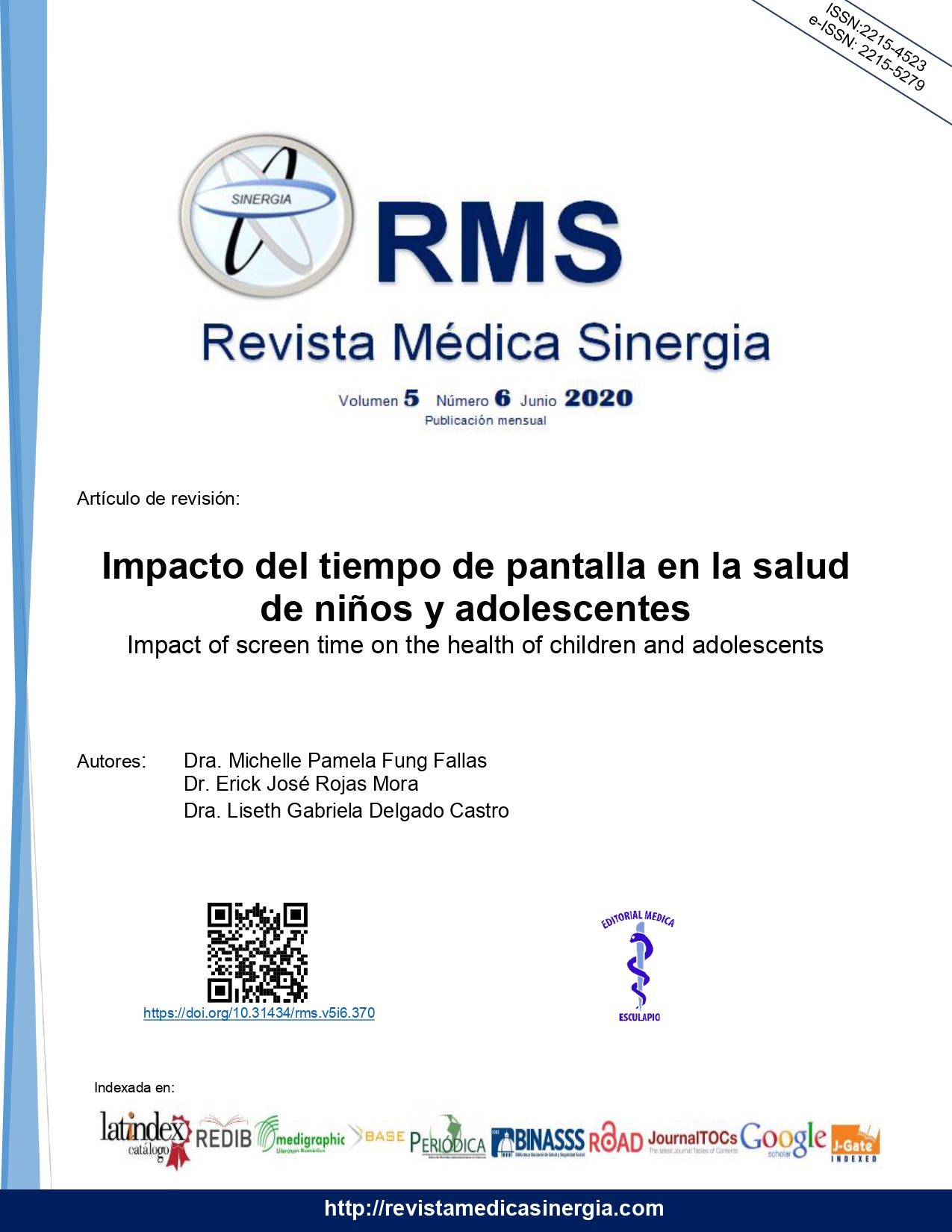Resumen
Actualmente, con la era tecnológica, las pantallas juegan un papel fundamental dentro de la sociedad, incluyendo niños y adolescentes, quienes en la última década han aumentado de manera exponencial su uso a diario. La falta de información genera que padres y cuidadores permitan el uso de estos dispositivos desde edades muy tempranas, creyendo que programas educativos ayudarán en el desarrollo del niño. Se ha asociado el tiempo de pantalla excesivo con alteraciones en diversos ámbitos de la salud, tales como: sedentarismo, cambios en el peso, alimentación, sueño, desarrollo y bienestar psicológico; influyendo en el desarrollo de los mismos factores tanto internos como externos al ambiente familiar. Es por ello que se debe concientizar a la población sobre las implicaciones negativas que conlleva el uso excesivo de las pantallas, así como también la importancia de la interacción con el mundo real para un adecuado desarrollo del menor.
Palabras clave
Citas
American Academy of Pediatrics. Media and Young Minds. Pediatrics. 2016;138(5):e20162591.
Chang H, Park E, Yoo H, Lee J, Shin Y. Electronic media exposure and use among toddlers. Psychiatry Investig. 2018;15(6):568–73. https://doi.org/10.30773/pi.2017.11.30.2
Hale L, Kirschen GW, LeBourgeois MK, Gradisar M, Garrison MM, Montgomery-Downs H, et al. Youth Screen Media Habits and Sleep: Sleep-Friendly Screen Behavior Recommendations for Clinicians, Educators, and Parents. Child Adolesc Psychiatr Clin N Am. 2018;27(2):229–45. https://doi.org/10.1016/j.chc.2017.11.014
Kaur N, Gupta M, Malhi P, Grover S. Screen Time in Under-five Children. Indian Pediatr. 2019;56(9):773–88. https://doi.org/10.1007/s13312-019-1638-8
Barber S, Kelly B, Collings P, Nagy L, Bywater T, Wright J. Prevalence, trajectories, and determinants of television viewing time in an ethnically diverse sample of young children from the UK. Int J Behav Nutr Phys Act. 2017;14(1):1–11. https://doi.org/10.1186/s12966-017-0541-8
Hill D, Ameenuddin N, Chassiakos YR, Cross C, Radesky J, Hutchinson J, et al. Media use in school-aged children and adolescents. Pediatrics. 2016;138(5). https://doi.org/10.1542/peds.2016-2592
Emond JA, Tantum LK, Gilbert-Diamond D, Kim SJ, Lansigan RK, Neelon SB. Household chaos and screen media use among preschool-aged children: a cross-sectional study. BMC Public Health. 2018;18(1):1–8. https://doi.org/10.1186/s12889-018-6113-2
Downing KL, Hinkley T, Salmon J, Hnatiuk JA, Hesketh KD. Do the correlates of screen time and sedentary time differ in preschool children? BMC Public Health. 2017;17(1):1–12. https://doi.org/10.1186/s12889-017-4195-x
Paudel S, Jancey J, Subedi N, Leavy J. Correlates of mobile screen media use among children aged 0-8: A systematic review. BMJ Open. 2017;7(10). https://doi.org/10.1136/bmjopen-2016-014585
Vogel L. Quality of kids’ screen time matters as much as quantity. C Can Med Assoc J. 2019;191(25):E721. https://doi.org/10.1503/cmaj.109-5767
Shqair AQ, Pauli LA, Costa VPP, Cenci M, Goettems ML. Screen time, dietary patterns and intake of potentially cariogenic food in children: A systematic review. J Dent. 2019;86(June):17–26. https://doi.org/10.1016/j.jdent.2019.06.004
Khoury M, Hayman L, Urbina E. Cardiovascular Risk Factors in Youth. In: Wernovsky G, Anderson R, Kumar K, Mussatto K, Redington A, Tweddell J, ed. by. Anderson's Pediatric Cardiology. 4th ed. Philadelphia: Elsevier; 2020. p. 423-437.
Twenge JM, Campbell WK. Associations between screen time and lower psychological well-being among children and adolescents: Evidence from a population-based study. Prev Med Reports. 2018;12(September 2018):271–83. https://doi.org/10.1016/j.pmedr.2018.10.003.
Jessy P, Nagar P, Tanvi P, Borse M. Clustering of Dental Caries and Risk of Obesity with Television Viewing among Bangalore North Adolescents. 2016;3(8):2267–70.
Avery A, Anderson C, McCullough F. Associations between children’s diet quality and watching television during meal or snack consumption: A systematic review. Matern Child Nutr. 2017;13(4). https://doi.org/10.1111/mcn.12428
Trofholz AC, Tate A, Loth K, Neumark-Sztainer D, Berge JM. Watching Television while Eating: Associations with Dietary Intake and Weight Status among a Diverse Sample of Young Children. J Acad Nutr Diet. 2019;119(9):1462–9. https://doi.org/10.1016/j.jand.2019.02.013
Twenge JM, Hisler GC, Krizan Z. Associations between screen time and sleep duration are primarily driven by portable electronic devices: evidence from a population-based study of U.S. children ages 0–17. Sleep Med. 2019;56:211–8. https://doi.org/10.1016/j.sleep.2018.11.009
Fisher PG. To sleep and dream without digital screens. J Pediatr. 2019;205:2. https://doi.org/10.1016/j.jpeds.2018.12.017
Madigan S, Browne D, Racine N, Mori C, Tough S. Association between Screen Time and Children’s Performance on a Developmental Screening Test. JAMA Pediatr. 2019;173(3):244–50. https://doi.org/10.1001/jamapediatrics.2018.5056
Chassiakos YR, Radesky J, Christakis D, Moreno MA, Cross C, Hill D, et al. Children and adolescents and digital media. Pediatrics. 2016;138(5). https://doi.org/10.1542/peds.2016-2593
Swartz MK. Taking Another Look at Screen Time for Young Children. J Pediatr Heal Care. 2017;31(2):141. http://dx.doi.org/10.1016/j.pedhc.2017.01.006


